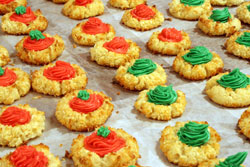 The “old timers” in Maine always eat salmon and peas for their fourth of July family feast. This tradition was started a long time ago when salmon still came “up river to spawn” and people still rushed in the Spring to plant their peas so they would have the first peas of the year, hopefully by the 4th, if the weather was good. (I still have customers that plant their peas in the fall so they sprout when they are ready come Spring.)
The “old timers” in Maine always eat salmon and peas for their fourth of July family feast. This tradition was started a long time ago when salmon still came “up river to spawn” and people still rushed in the Spring to plant their peas so they would have the first peas of the year, hopefully by the 4th, if the weather was good. (I still have customers that plant their peas in the fall so they sprout when they are ready come Spring.)
The old tradition is to bake a center cut chunk of salmon at 350 degrees till it is less than moist, (so all the relatives like it) than nap it with a white sauce, better known as a béchamel sauce to which you add in chopped hard cooked eggs. And peas, lot of peas cooked with butter, salt, pepper and a little water. The rule of thumb was to cook them till when you blew on a spoonful they wrinkled.

 The festiveness of the holidays is upon us and it's time to make a plan of attack. What to serve? How to serve it? What I am bringing where? And how the heck am I going to feed all these people?
The festiveness of the holidays is upon us and it's time to make a plan of attack. What to serve? How to serve it? What I am bringing where? And how the heck am I going to feed all these people? It was the day after Christmas, we’d had too much sugar and a fair share of post-modern stress so, it was probably a bad idea to try to go “sale” shopping.
It was the day after Christmas, we’d had too much sugar and a fair share of post-modern stress so, it was probably a bad idea to try to go “sale” shopping.  Christmas is not complete without gingerbread, be it houses, cookies, cake, or any dessert flavored with those warm spices of ground ginger, cinnamon, and nutmeg. The dense spicy cake traces its roots to 11th
century Europe. There are so many versions from eastern Europe all the
way to Scandinavia, but I'm focusing on the cookie. In Germany there is
Lebkuchen and Pfeffernüsse. In Hungary, gingerbread cookies are called
Puszedli. They look just like Lebkuchen, but are smaller. Polish
Pierniki are also quite special cookies. The town of Toruń is famous
for their heart-shaped cookies, filled with jam and covered in
chocolate. These cookies all share similar ingredients and flavors.
Christmas is not complete without gingerbread, be it houses, cookies, cake, or any dessert flavored with those warm spices of ground ginger, cinnamon, and nutmeg. The dense spicy cake traces its roots to 11th
century Europe. There are so many versions from eastern Europe all the
way to Scandinavia, but I'm focusing on the cookie. In Germany there is
Lebkuchen and Pfeffernüsse. In Hungary, gingerbread cookies are called
Puszedli. They look just like Lebkuchen, but are smaller. Polish
Pierniki are also quite special cookies. The town of Toruń is famous
for their heart-shaped cookies, filled with jam and covered in
chocolate. These cookies all share similar ingredients and flavors. For as long as I can remember, Thumbprint Cookies have been my favorite holiday cookie treat. My paternal grandmother started the Thumbprint tradition. The cookies soon became a favorite of her little son Ronny (my dad.) So, of course, my mom had to learn how to make them and carry on the Thumbprint tradition. My mom’s been gone for many years, so the Thumbprint tradition was left to me. I’m certain the tradition will be carried on for generations. My daughter-in-law makes them now, too.
For as long as I can remember, Thumbprint Cookies have been my favorite holiday cookie treat. My paternal grandmother started the Thumbprint tradition. The cookies soon became a favorite of her little son Ronny (my dad.) So, of course, my mom had to learn how to make them and carry on the Thumbprint tradition. My mom’s been gone for many years, so the Thumbprint tradition was left to me. I’m certain the tradition will be carried on for generations. My daughter-in-law makes them now, too.